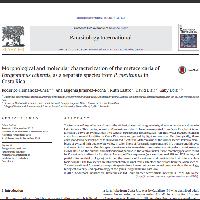Resumen
- The trematode Paragonimus mexicanus is the etiological agent of paragonimiasis, a food-borne zoonotic disease in Latin America. This species, as well as Paragonimus caliensis, have been reported from Costa Rica, but it is not known if the two are synonymous. Two types of Paragonimus metacercariae from freshwater pseudothelphusid crabs from several localities in Costa Rica were recognized by light microscopy. Morphologically, these corresponded to descriptions of P. mexicanus and P. caliensis. Metacercariae of the former species lacked a membrane or cyst and their bodies were yellow in color. Those of P. caliensis were contained in a transparent thin cyst and were pink in color. Morphotypes of metacercariae were determined using scanning electron microscopy (SEM). Based on the number and distribution of papillae in the ventral sucker, three morphotypes were found for P. mexicanus and two for P. caliensis. Analysis of DNA sequences (nuclear ribosomal 28S and ITS2 genes, and partial mitochondrial cox1 gene) confirmed the presence of P. mexicanus and provided the first molecular data for P. caliensis. The two species are phylogenetically distinct from each other and distant from the Asian species. The confirmation of P. caliensis as a separate species from P. mexicanus raises several questions about the ecology, biological diversity, and epidemiology of the genus Paragonimus in Costa Rica.
